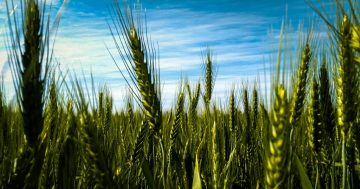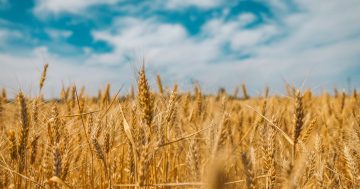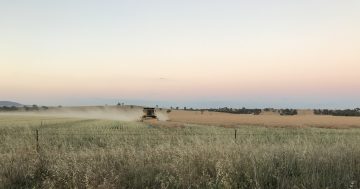
Thuddungra farmer Broden Holland, pictured here with Cootamundra MP Steph Cooke, estimates the mid-September cold snap impacted around 20 per cent of his crops. Photo: Steph Cooke.
When mid-September temperatures across the South West Slopes plummeted way below the worst the 2024 winter had to offer, it was the farmers who were most savagely impacted.
In the six days below zero temperatures delivered frosty conditions across the region between 14 and 20 September, the Bureau of Meterology recorded overnight temperatures between -1.4 to -5.3 degrees Celsius at Young and Cootamundra.
Greenethorpe’s Rob Taylor observed a maximum of -6 degrees Celsius across the private weather stations he has scattered across his farm.
“We had four frosts in a row but it was that minus six one that really did the damage; it was a freezing night that went negative at about 11 pm and didn’t thaw until about 8 am,” he said.
Cold or chilling damage occurs when the winter crops, such as canola, wheat and barley, are exposed to temperatures less than 10 degrees Celsius down to -2 degrees Celsius.
At a time when conditions were expected to ease, the impact of frost on canola results in either total loss of the flowering heads, leaving just stalks, or a mottling and blistering of seed pods, leaving shrivelled or no seeds.
Wheat and barley crops, also at a critical time of development, will either be rendered sterile or produce unviable seedheads.
But this week as farmers roll out the heavy machinery in preparation for harvest, which has begun in earnest in the Riverina and western reaches of the Hilltops local government areas, the true cost of the weather will be calculated.
Fourth-generation Thuddungra farmer Broden Holland said he was more fortunate than some farmers as temperatures on his mixed cropping enterprise dropped to three below zero between 14 and 20 September.
He estimated the frost caused around 20 per cent total damage to his crops, but said expectations across the region would be a far cry from the predicted bumper crops in previously favourable conditions.
“With the year we’ve ended up having, this has probably pegged us back to where we were going to get to anyway,” Mr Holland said.
“Certainly, the further you go west, they’ve gone from a possible bumper crop to a below average crop now.”
Mr Holland said the yearly income loss as the result of weather such as this was immense.
“We can lose a lot of income in one year, rather than over the span of four or five years,” he said.
“A frost event like this can have a much bigger impact on the bottom line than a drought because we’ve spent the money – in a drought, you can see the impact, so you don’t spend the money,” he said.
“Now, we’ve spent so much in a big year and to lose it in the click of a finger, that’s when it hurts.”
That’s why Cootamundra MP Steph Cooke has written to NSW Agriculture Minister Tara Moriarty, calling for continued investment in research and development in both state and federal agriculture portfolios.
The annual value of agricultural production in the electorate, which encompasses Cowra, Hilltops, Bland, Weddin, Temora, Junee, Cootamundra-Gundagai, Narrandera and Coolamon local government areas is close to $2.5 billion.
Ms Cooke said agronomists working in Coolamon and Boorowa reported crop damage totalling up to $500 a hectare in badly affected paddocks, with losses of up to 70 per cent.
“What was looking to be an excellent season has turned into heartbreak for too many of our primary producers. One agronomist has called this frost the worst he has ever seen,” Ms Cooke said.
“After tough conditions last year, it’s yet another blow for those who grow our food and fibre, at a time where interest rates and the cost of doing business continue to climb.”
With preparations to either make hay from damaged crops, work on salvaging a harvest, or offering a decent value crop for grazing stock all well underway, Ms Cooke said producers are handling the event as best they can, in challenging circumstances.
“The pace at which our agriculture sector is innovating for solutions is astounding, but during these times of unpredictable weather events, we are reminded of just how far we have to go,” Ms Cooke said.
She said events like these were proof-positive of the need for further research and development to understand how to best reduce frost damage through resilient crops, and to better predict long-term weather patterns so farmers could prepare.
“Working together with the Department of Primary Industries and Regional Development, the Department of Agriculture, the Bureau of Meteorology and our research stations in Boorowa and Cowra, we can find ways to identify severe weather anomalies and reduce crop losses into the future,” she said.











